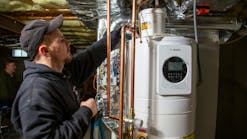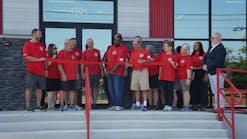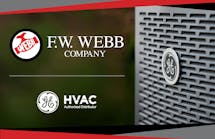Radiant heating, primarily floor heating in both hydronic and electric forms, is showing up on a regular basis in trade publications, home improvement magazines, building design magazines and green building periodicals. It is seen on TV, creating crowds at builder and home shows, specified by architects and even sold directly over the Internet. It is a product that is making its way into acceptance in the heating market.
Even though radiant heating is anything but new, the mounting interest is. The desire and ability to afford comfort and the focus on saving energy have turned a lot of heads in the direction of radiant heating in its various forms. The challenge is to equip contractors with knowledge, skills and products to service this growing market. It is a market that is holding its own, even in a down economy.
Where does the support for these radiant contractors come from? More often than not, it doesn't come through the traditional supply chain. In fact, all too often, the contractor is getting very little support and venturing into the arena of radiant heating with little more than a cursory education gained from reading a few articles and applying common sense. Unfortunately, that often leads to poorly designed and installed systems as well as dissatisfied customers.
The radiant industry is trying to grow up. As a burgeoning industry, it found that most wholesale distributors were not too interested in stocking piles of tubing or electric elements, an assortment of manifolds and shelves of controls needed to service the occasional radiant heating job. The industry also discovered that full-service wholesalers of hydronic products were not plentiful. This forced manufacturers to market their products directly to the contractor and to the end-user in order to create a pull-through demand when the wholesale houses would not step up to the task.
A few wholesalers caught the vision and picked up the radiant line as a feature. Some were born out of the radiant movement, and others adapted. Those that began servicing the radiant niche found not only better profit margins but also contractors that were a cut above the average. Wholesale distributing companies like Hydronics Specialties Company in Oakland, CA, How Hydronics in Baldwinsville, NY, and Northern Wholesale Supply in Lino Lakes, MN, found a thriving business in supporting the radiant heating industry.
But these successful wholesale distributors didn't just hang out a sign heralding their entrance into the radiant market. They have actively promoted radiant heating to architects, engineers, builders and mechanical contractors. They offer continuous training, stay up on the latest technology and often offer system design assistance to their customers. They have radiant specialists on staff to answer questions and give guidance.
The demand is out there, and it is growing. Even with a downturn in the residential housing markets, upscale home and commercial building is still going strong. The retrofit market is also firing up as housing starts slow.
Radiant heating is a natural for the “green” movement. It promotes a healthier indoor environment because it has no ductwork, doesn't move dust and allergens around, and pretty much eliminates cold drafts on the floor. It saves energy by putting the heat where the occupant is, not at the ceiling or windows and doors. You can easily zone it for comfort and energy management. Radiant floors make green floor covering like wood, linoleum, stone or tile far more comfortable and, therefore, more appealing.
On top of all that, radiant heating is not only an excellent companion for solar or geothermal equipment, it actually enhances their performance. Because of the low water temperatures required by radiant heating as compared to forced air or even baseboard convectors, solar collectors and geothermal heat pumps can operate at lower temperature ranges, where their efficiencies increase. This low water temperature advantage also allows condensing boilers to operate at their peak efficiencies.
Radiant technology isn't only restricted to heating. Cooling is also possible with radiant. In all but arid climates like California or Colorado, radiant cooling is usually married with a simple air system for removing humidity to avoid condensation. These marriages can be very beneficial in both comfort and energy efficiency. In countries like Austria, this technology has become the leading form of space cooling. And it is rapidly spreading all across Europe.
For wholesale distributors, this is a time of opportunity. The radiant field is wide open in most parts of North America. There are consumers begging for radiant heating and contractors begging for wholesalers that will support them. One of the most common complaints we receive at the Radiant Panel Association (RPA) from consumers is that they cannot find anyone to install a radiant heating system. The wholesale distributor is in the best position of filling those needs and creating business at the same time.
Many contractors would venture into the radiant heating market if they had local support. Taking a quick training course from one of the manufacturers is a good way to pique an interest, but it is no substitute for reliable support from a local supplier.
Radiant heating is deceptively simple and confoundingly complex at the same time. Once one knows how to design and install systems, the simplicity becomes apparent, particularly when properly applied. While basically simple, there is also the ability to add features and complexities to handle almost any desired outcome. A system could consist of a water heater, pump, manifold, tube and a line voltage thermostat. Or it could consist of a wall of controls, motorized mixing valves, zone valves, pressure differential valves, outdoor resets and any number of zones. The expertise comes in knowing when one or the other is appropriate and how to apply it.
Unfortunately, too many contractors see a few pictures in a magazine, read an article or two and figure, “How hard can it be? Throw some tube in the slab, hook up a pump and a boiler, and you have a system.” Without the support of a knowledgeable local supplier, these jobs turn into trouble calls and unhappy customers. The next thing you know, the word is out that radiant is problematic and doesn't work. A great opportunity to make people comfortable, energy-efficient and happy at a profit is damaged, if not destroyed.
Manufacturers are looking for good wholesale distributors for their products. They are willing to work with the supplier to educate members of their staff and to be creative in inventory requirements. The wholesaler that trains the contractor not only gains a customer but also gains an element of loyalty. That loyalty receives further reinforcement with good, ongoing technical support.
The Radiant Panel Association is a good resource and offers a series of courses on radiant technology. Classroom, home study and even live webinar schools are available. Wholesale suppliers can sponsor classes using live instructors or work through courses together in classroom style using a computer and data projector. Through the RPA Certification Program, a supplier can become an Authorized Certification Testing Facility, thereby providing a valuable service to their customers who want to become an RPA Certified Installer or Designer.
There is no doubt that radiant heating will continue to rise in popularity. The supplier that catches the vision and prepares now will reap the rewards in years to come.
Lawrence Drake is the executive director of the Radiant Panel Association. The association is a nonprofit trade organization made up of contractors, sales reps, distributors, manufacturers and professionals supporting the radiant panel heating and cooling industry. For more information, visit www.radiantpanelassociation.org or call 800/660-7187.








